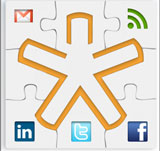Social CRM
Deep Dive into Nimble Social CRM
Salespeople connect and interact with their customers in a variety of networks and channels. They live in their calendar, email, and contacts address book—none of which are connected.
This is the problem that Nimble solves. One of the value propositions of the Nimble platform is its ability to bring together your contacts from a multitude of disparate channels—Gmail, Outlook, LinkedIn, Twitter, Facebook, to name a few—and consolidate and synchronize them into one central location within Nimble.
To put it simply, Nimble is a contact management system juiced up on social steroids. But it also does more than just that.
In our Nimble Q&A, CEO Jon Ferrara shared his insights about how social media has transformed customer relationships and how Nimble empowers this new paradigm of CRM. In this Deep Dive, take a closer look at how Nimble really works. Scroll through the slideshow below to see Nimble in action.
[SlideDeck2 id=32857]
Nimble is more than “Social Contact Management”
 Today, we communicate with contacts in a variety of platforms, requiring us to have different tabs and different browsers open on our desktops. Contacts are kept in Google, Outlook, LinkedIn, Facebook, and whatever system you may have in place. It’s hard to see who said what to who and when.
Today, we communicate with contacts in a variety of platforms, requiring us to have different tabs and different browsers open on our desktops. Contacts are kept in Google, Outlook, LinkedIn, Facebook, and whatever system you may have in place. It’s hard to see who said what to who and when.
Adding to that complexity is the growing penetration of social media into customer communications. Prospects and customers are interacting on social networks, bypassing traditional marketing and sales channels. In order to effectively engage, businesses need to go where their customers are and that has increasingly become social networks such as Twitter, Facebook, LinkedIn, and Google+. Nimble integrates your social networks and contact information, so that you can uncover more opportunities for engagement in various social streams.
Getting Started in Nimble
To get started with Nimble, all you have to do is import your contacts from wherever they may reside: Twitter, Facebook, LinkedIn, Google, and Outlook. Nimble maps out your contacts, synchronizing all your communications and calendars. A record is created for each contact, and all the related communications and social profiles are consolidated, giving you a single view of who that contact is, how you know them, and how you have interacted with them.
Why You Should Consider Nimble
Why were we wowed by Nimble? It’s just a contact management system with social thrown in for good measure, right? Wrong. What makes Nimble so awesome is that it brings together all your contact information—wherever they may lie. All you have to do is import your contacts into Nimble; Nimble does the rest of the work, synching information, communication, activities, events, tasks, and more. Nimble makes it easy to keep up to date with your contacts because it does it automatically for you.
Nimble: The Unified Inbox
![]() Most people are accustomed to using the processes they have already set for themselves to complete their tasks and activities. Transitioning people to work within a new system can sometimes be a difficult process. With Nimble, you get the option to work within Gmail, Outlook, Twitter, or whatever platform you want to. Everything gets synced together—automatically.
Most people are accustomed to using the processes they have already set for themselves to complete their tasks and activities. Transitioning people to work within a new system can sometimes be a difficult process. With Nimble, you get the option to work within Gmail, Outlook, Twitter, or whatever platform you want to. Everything gets synced together—automatically.
Tired of logging into your email account, then into Twitter, then into LinkedIn or Facebook to find your contacts and any communications you may have had with them? Now you don’t have to switch back and forth. Nimble provides a unified inbox for all your contacts, no matter what network. You can easily send messages to each of your different social networks and email accounts, all within the Nimble system. Attached to working within your Gmail account? Not a problem. Nimble allows you to work both within and outside the system, using whatever networks you prefer. All of it gets automatically synched into Nimble without any extra effort on your part.
Whatever communication channels you use, everything is automatically synched to Nimble so you always have a current view of all your messages and contact information.
Contact Records
![]() Once all your contacts have been imported, a record is created that contains all the relevant information you need to know about who the contact is (including activity in social networks and shared connections) and what communications, notes, and activities you’ve conducted with him. A nifty feature is the ability to add tags to each contact, making it easy to search through records, even when you don’t remember a specific contact’s name.
Once all your contacts have been imported, a record is created that contains all the relevant information you need to know about who the contact is (including activity in social networks and shared connections) and what communications, notes, and activities you’ve conducted with him. A nifty feature is the ability to add tags to each contact, making it easy to search through records, even when you don’t remember a specific contact’s name.
Social Stream
![]() Nimble makes it easy to monitor the social conversations on Facebook, Twitter, or LinkedIn by displaying all these conversations and interactions in one place, saving you from having to log into a number of different social accounts. A contact’s social conversations across Twitter, Facebook, and LinkedIn are also displayed in the contact record, so that you stay up-to-date with the latest news and activities your contact is having. A notifications tab ensures that you know who has been interacting with you so that you can effectively engage with your followers across all your social networks.
Nimble makes it easy to monitor the social conversations on Facebook, Twitter, or LinkedIn by displaying all these conversations and interactions in one place, saving you from having to log into a number of different social accounts. A contact’s social conversations across Twitter, Facebook, and LinkedIn are also displayed in the contact record, so that you stay up-to-date with the latest news and activities your contact is having. A notifications tab ensures that you know who has been interacting with you so that you can effectively engage with your followers across all your social networks.
Activities
![]() Tasks, events, and calendars can be seen on a single screen. Google Calendar and events inputted into Nimble are automatically synched together and your tasks and events can be displayed in a graphical calendar view. Activities can be assigned to team members and related to contacts, which will then be displayed in that contact’s record. Activities and tasks can be created from the Contacts, Messages, Activities, Deals, or Social tabs. Activities can also be created from Tweets, status updates, emails, and more.
Tasks, events, and calendars can be seen on a single screen. Google Calendar and events inputted into Nimble are automatically synched together and your tasks and events can be displayed in a graphical calendar view. Activities can be assigned to team members and related to contacts, which will then be displayed in that contact’s record. Activities and tasks can be created from the Contacts, Messages, Activities, Deals, or Social tabs. Activities can also be created from Tweets, status updates, emails, and more.
Deals
![]() Deals can be tracked based on if they are in progress, won, or lost. A deal “contact record” is created in the system where all communications and activities are grouped together. But reporting features are rather light. If you want to create reports, you’ll have to export your deal data into a CSV file to download. Currently, Nimble doesn’t offer much in the way of reporting and forecasting. If this is an important must-have feature for your sales team, you may need to consider other options to meet your reporting needs.
Deals can be tracked based on if they are in progress, won, or lost. A deal “contact record” is created in the system where all communications and activities are grouped together. But reporting features are rather light. If you want to create reports, you’ll have to export your deal data into a CSV file to download. Currently, Nimble doesn’t offer much in the way of reporting and forecasting. If this is an important must-have feature for your sales team, you may need to consider other options to meet your reporting needs.
Nimble Overall
 At its core, Nimble is all about better managing and engaging with contacts by showing all you need to know about them, including their social walls and profiles, so that you can leverage this social stream to better engage with prospects and customers.
At its core, Nimble is all about better managing and engaging with contacts by showing all you need to know about them, including their social walls and profiles, so that you can leverage this social stream to better engage with prospects and customers.
Nimble envisions itself as an engagement platform, being the front-end to any CRM platform and the hub that connects to other applications via integrations with other platforms, such as MailChimp for email marketing, Hubspot for inbound marketing, and Wufoo for lead management.
Plus, you can’t beat the pricing. Nimble is free for the basic version, which accommodates a single user account. The business version is available for only $15 per month per user and it comes with a free 30-day trial.
Nimble: Closing Thoughts
According to Jon Ferrara, “most CRM are legacy tools that most people don’t enjoy being in.” So, he created Nimble to be the opposite of that. With a clean, intuitive interface and a system that gives you the freedom to work the way you actually work, Nimble is an integrated, unified communications portal to manage your contacts and manage them in a way that takes into account how social conversations and connections have changed how businesses and customers interact with each other.
Learn more about the industry’s leading solution by downloading our Top 10 Social CRM Software report.





